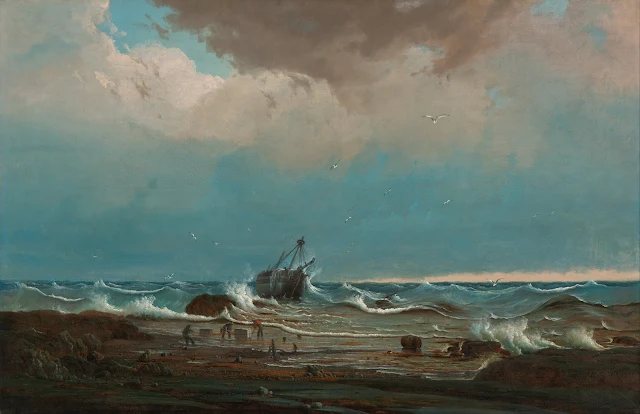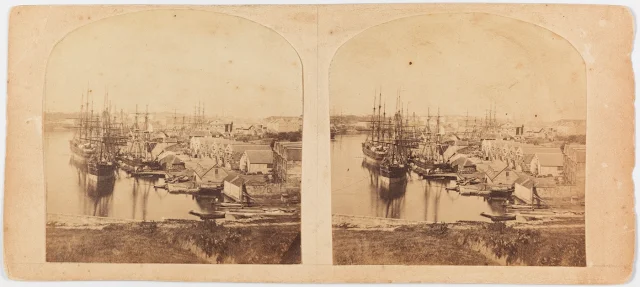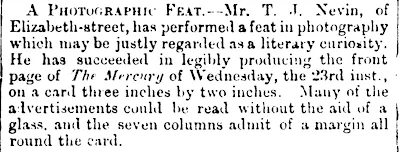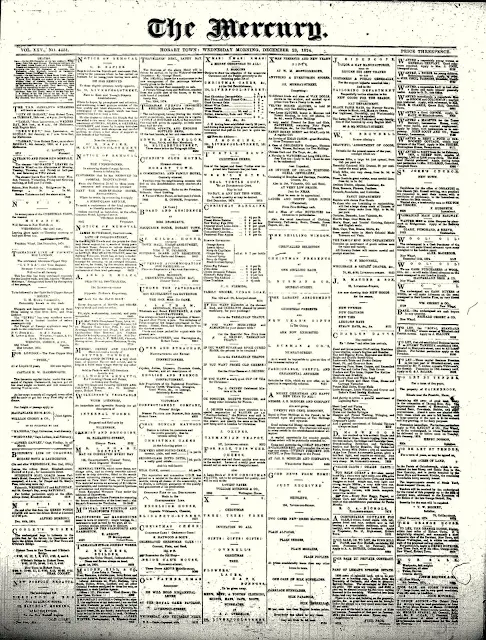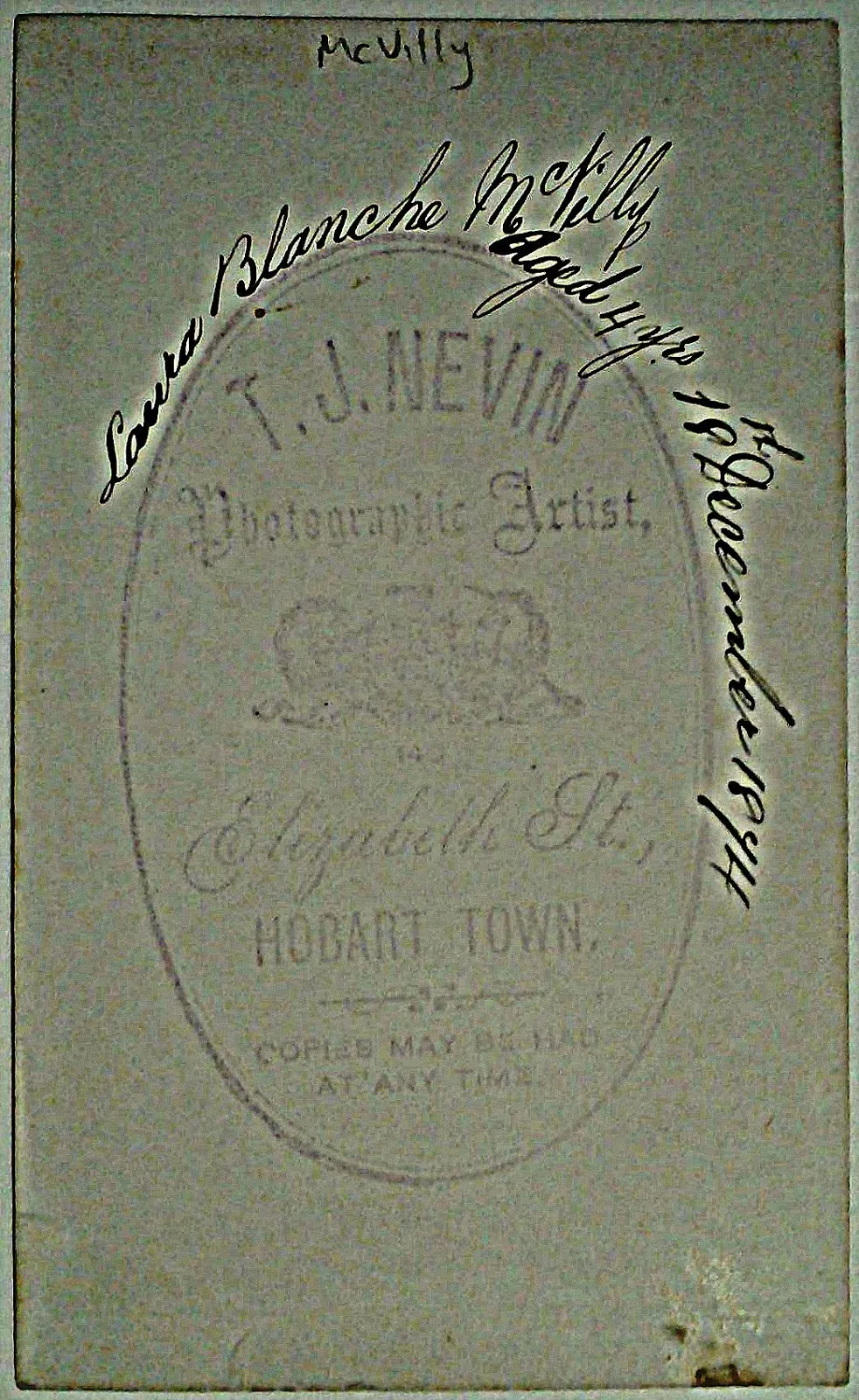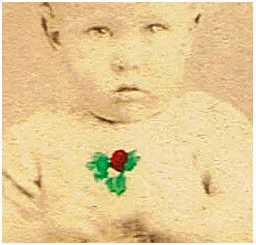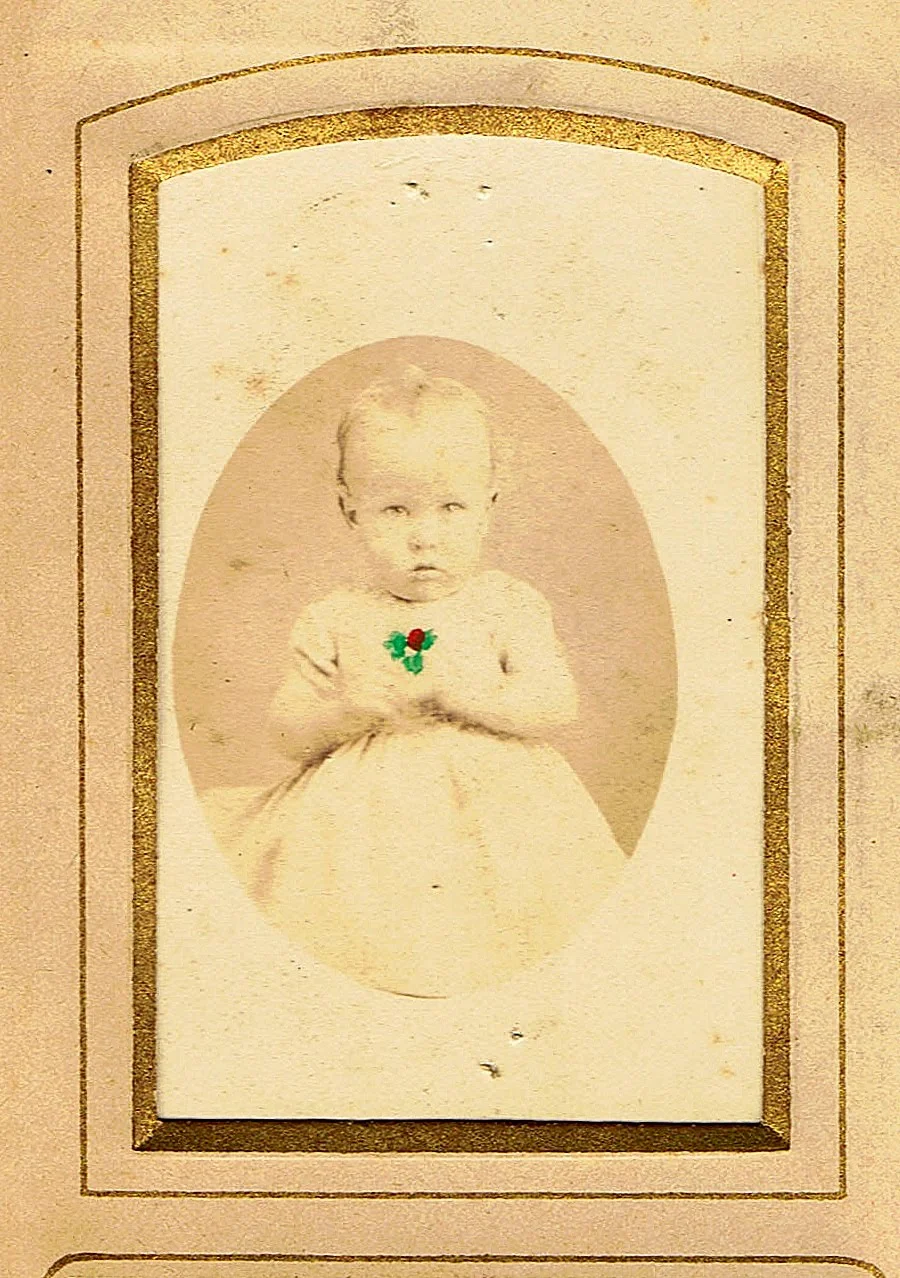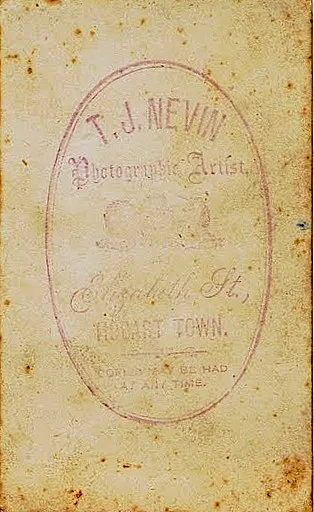
NZ police mugshot of Amy Bock [n.d. but probably 1890]
New Zealand Police Museum online exhibition. March 2010.
Amy Maud Bock (1859–1943) was born on 18th May 1859 at her father's photographic studio, The City Photographic Establishment, 140 Elizabeth St. Hobart, Tasmania, to Alfred Bock and Mary Ann Parkinson, second daughter of Robert Parkinson of Hobart. They had married on 24th July, 1858.
BIRTHSBirth of Amy Bock at the City Photographic Establishment 18 May 1859
On May 18th, at her residence, 140 Elizabeth-street, the wife of Alfred Bock of a Daughter.
Source: The Courier (Hobart, Tas. : 1840 - 1859) Thu 19 May 1859 Page 2 Family Notices
Thomas J. Nevin was seventeen years old when Amy Bock was born. By 1863, now 21 yrs old, he would have been a friendly face to the four-year old toddler Amy while assisting her father Alfred Bock with studio portraiture in the glass house constructed at the back of the studio premises. It was located at the end of the laneway at 138½ Elizabeth-street. Thomas Nevin had established himself as a professional photographer within the Hobart cohort of photographers, especially with Samuel Clifford as well as Alfred Bock by 1864, and was operating principally from his studio at New Town, but on Alfred Bock's insolvency in 1865 and departure from Tasmania in 1867 he acquired Bock's negative stock, furnishings, studio lease, and glass house at auction and continued with the business under the same name, the City Photographic Establishment, 140 Elizabeth Street, Hobart until 1876.

A view of the City Photographic Establishment studio
Thomas Nevin's studio, formerly Alfred Bock's. third door down on right side of Elizabeth St. Hobart
Stereograph by T. J. Nevin ca. 1867
TMAG Ref: Q1994-56-33

Photographic studio where Amy Bock was born
The City Photographic Establishment
140 Elizabeth St Hobart
Stereograph by Thomas J. Nevin ca. 1868
TMAG Ref: Q1994-56-12
Alfred Bock's (half) brother William Rose Bock was a teenager when he served more than two and half years as Alfred's apprentice in the studio at the City Photographic Establishment, 140 Elizabeth-street, Hobart Town from 1863-1865. Alfred Bock was born on 19 April 1837 to Mary Ann Cameron nee Spencer and Alexander Cameron. William Bock was born on 5 January 1847 to Mary Ann Cameron nee Spencer and Thomas Bock. William Bock left Tasmania in 1868, returned in 1874 to marry his fiance Rebecca Finlay, and settled back in Wellington New Zealand where he thrived as an engraver, lithographic printer, medallist, stamp designer, and illuminator. He died in 1932.
Alfred Bock moved his family from Tasmania to Sale, Victoria, in 1867 and to Melbourne in 1874. His first wife Mary Ann Parkinson died in Melbourne on 14th January 1875. The first five of their six children were born in Hobart. Alfred Bock married again to Eleanor Rachel Blackburn on 25th March 1882 in Melbourne. She was the granddaughter of architect James Blackburn. They moved to Auckland, New Zealand in 1882 where the three eldest sons of their seven children were born. But by 1887, Alfred Bock and family were back in Melbourne where they stayed until ca. 1906. Alfred Bock retired from business and moved to Wynyard, Tasmania where he died on 19th February 1920, survived by his wife and several of their children.
Alfred Bock's eldest daughter Amy Bock found employment as a teacher in Gippsland, Victoria but in 1885 she was summoned for acquiring goods on false credit. Her father suggested she move to Auckland, New Zealand, where he was living with his second wife Eleanor Rachel Bock nee Blackburn.
Amy Bock's Criminal Career
The first notice of Amy Bock's series of offences appeared in the New Zealand Herald on 14th May 1885. Read these excerpts at this link: Papers Past New Zealand, search term: "Amy Bock". The following extract is from the biography written by Fiona Farrell, first published in the Dictionary of New Zealand Biography, vol 2, 1993:
Amy Bock's first officially recorded appearance before the New Zealand authorities was in April 1886 in the Resident Magistrate's Court in Wellington, where she was charged with buying goods on credit in Christchurch and then disappearing. Remanded to Christchurch, she was sentenced to one month's hard labour at Addington gaol. On her release she lived in Wellington, but by July 1887 she was back in court on fraud charges. She was sentenced to six months' detention at Caversham Industrial School, Dunedin, where she so impressed the superintendent with her intelligence and 'ladylike deportment' that he offered her employment as a teacher. The position came to an abrupt end when she was discovered attempting to engineer her escape by forging letters from an affectionate but alas fictitious aunt. In January 1888 she left the school and advertised as a music teacher, but by April she was in court charged with obtaining goods on false credit and was sentenced to two months' imprisonment. After her release she remained in Dunedin, later moving to Hill Top near Akaroa where she worked as a governess, before receiving concurrent six-month sentences for larceny and false pretences in April 1889. At the end of the year she returned to Dunedin where she found a job as a housekeeper until mid 1890, when she pawned her employer's furniture. This time she received the maximum penalty: three years' imprisonment with hard labour.Source: Te Ara the Encyclopeadia of New Zealand
In October 1892 Amy Bock emerged from prison with £1 9s. in her pocket, some of which she spent on a ticket to Timaru where she fraudulently obtained £1. Discharged from prison in November, she joined the Salvation Army and lived with Army members in Timaru, but by Easter 1893 she was in trouble for selling her landlady's watch. After serving her six-month sentence she moved to Oamaru, where she procured various trifling amounts of money, attempted to defraud a furniture vendor of a larger sum and was in prison again by January the following year.
In 1895, after serving another three-month sentence for leaving a house owing board and lodging, Bock disappeared from official notice for several years. Some of this time she spent at the Magdalen Asylum for 'fallen' women, near Christchurch. In 1902 she appeared in Christchurch as Molly (or Mary) Shannon, and through an elaborate deception which took her to Wellington and Auckland borrowed substantial amounts of money to finance the purchase of a poultry farm. This escapade earned her two years' imprisonment in March 1903. Late the following year, after remission for good behaviour, she found work at Rakaia, now using the name Amy Chanel, but in February 1905 she was charged with altering a cheque and given a three-year sentence.
In June 1907 she was released from prison and for a year lived quietly in Christchurch. In 1908 she returned to Dunedin where, as Agnes Vallance, she pawned her employer's furniture and went to ground after delaying pursuit by creating a complex scenario through letters from Miss Vallance's concerned 'friend', Charlotte Skevington. It was at this point that she found the perfect disguise, posing as the wealthy sheepfarmer Percival Leonard Carol Redwood. Percy holidayed at Port Molyneux on the South Otago coast, staying at the Albion House boarding establishment, where he paid court to the landlady's daughter, Agnes Ottaway, and within a few weeks the couple were engaged. Bock managed to maintain the appearance of wealth by a succession of deceptions involving letters to lawyers, postal orders and small personal loans. These were not detected until after the elaborate wedding, which took place at the bride's home on 21 April 1909. Four days later Bock was arrested at the Ottaways' boarding house. She was convicted in the Dunedin Supreme Court on 27 May on two counts of false pretences and one of forgery, and was finally declared a habitual criminal. (The marriage was annulled on 17 June 1909.)
https://teara.govt.nz/en/biographies/2b30/bock-amy-maud

NZ police mugshot of Amy Bock [n.d. but probably 1890]
Source: Nichols, Chelsea. "Suspicious Looking: 19th Century Mug Shots in the Collection of the New Zealand Police Museum." New Zealand Police Museum online exhibition. March 2010.
Link: New Zealand Police Museum
The New Zealand press "went wild" with this story, as related by Sorrel Hoskin
In 1909 Amy invented the persona of Percival Redwood, a pipe smoking, well dressed man of small stature and high voice. Percy was a man of independent means – he owned shares in a North Island sheep farm – and was generous with his money, spending it lavishly on others – despite the fact that Bock was almost penniless. He made many friends in the small community of Port Molyneux in South Otago, including Agnes Ottaway, the landlady's daughter. Agnes and Percy got engaged and it's here that Percy's world began to unravel. His funds ran out and he had to devise other ways to keep up appearances and his generous disposition. Agnes's parents were a little suspicious of the new man in her life – but their worries were eased when letters began arriving from Percy's mother reassuring them of her son's financial position. Percy made up stories and borrowed money from friends and unsuspecting lawyers, bought an engagement ring on false credit and built lie upon lie to convince everyone of his status as a well–off man.
There were rumours in the build–up to the marriage, Percy was a source of interest in the community – his small wizened face, and sharp perky bearing raised curiosity everywhere. Jack Muir the barber later said Percy was a ‘curious lookin' little cuss', but at the same time thought he was ‘merely a very peculiar specimen of his kind.’
Percy had to do some fast talking when the debtors came to call, and again when his ‘mother’ wrote to say the family wouldn't be attending his wedding. Although suspicious, no–one said anything.
The society wedding went ahead on 21 April 1909. At the altar Percy murmured his vows and kissed the bride before a large group of guests, including the local MP and the press. Afterwards they gathered in a large decorated marquee, the tables were laden with food and presents, there was speeches and dancing. The newly married couple were travelling to Melbourne for their honeymoon.
But beneath the surface was a murmuring of discontent. The bride was subdued and kept her distance from her new husband, rumours were floating among the guests: the question on everybody's lips was – where would Percy sleep that night?
Percy didn't get to sleep with his bride. The Ottaway family were suspicious about his claimed riches. He was told to bunk in the same room as the groomsman who was intrigued when the newly married man leapt into bed with his pyjamas on over his wedding clothes.
The next day Percy claimed his mother was on her way down South and all debts would be repaid. The newly married man was given a week's grace – but would not be sleeping with his bride before then.
The wedding had taken place on a Wednesday – by Sunday the police were at the front door confronting Redwood with the words: ‘The game's up, Amy!’ The giveaway had been a basket of women's clothes found in a room at a Dunedin boarding house used by Redwood. Amy admitted all and was arrested for male impersonation and fraud.
The national media went wild. Bock's scam quickly became the object of jokes around the country. Postcards and a booklet The Adventures of Amy Bock were produced to capitalise on the interest in the case.
The Ottaway's were understandably shocked. Poor Agnes, horrified at the part she played in ‘New Zealand's most notorious’ wedding quickly had the marriage annulled. She later married a ‘real’ man.
Amy, who told the court she was 46, was charged with false pretences and forgery. She was declared a habitual criminal and sentenced to two years in the New Plymouth Prison.

Photographs of Amy Bock were taken by Guy [?] above, and Pattilo, below.


Tasmanian readers of the Weekly Courier, 20 May 1909 were provided with the Pattilo photo, Amy Bock as Percy Carol Redwood, and another earlier photo of Amy Bock, Photos 1 and 2 top left on page 22.
The "divorce":
AMY BOCK DIVORCED.Source: GREYMOUTH EVENING STAR, 18 JUNE 1909
END OF A SENSATIONAL INCIDENT. [BY TELEGRAPH.—PER PRESS ASSOCIATION.] DUNEDIN, This Day. At the Divorce Court to-day, Agnes Ottoway's marriage with Amy Bock was annulled by Mr Judge Williams

AMY BOCK SKETCHED IN THE DOCK IN THE DUNEDIN CITY POLICE COURT.
OTAGO WITNESS, ISSUE 2878, 12 MAY 1909
Source: Papers Past New Zealand Newspapers

Sourced from Wikipedia - Amy Bock, confidence trickster of the early 20th century. Photo from 1908/1909, taken from the Dictionary of New Zealand Biography published by New Zealand's Ministry of Culture and Heritage
RELATED POSTS main weblog
- Photographers A. Bock, S. Clifford and T. Nevin at Port Arthur
- Two couples, two dogs by A. Bock and T. Nevin
- One of the last portraits by Alfred Bock in Hobart 1865
- Alfred Bock's other apprentice; William Bock
- With Alfred Bock at The City Photographic Establishment
EXTERNAL LINKS
- The Bridegroom Was a Woman - Taranaki Story
- Suspicious Looking: 19th century mug shots from the New Zealand Police Museum
- Amy Bock at Wikipedia

Mad Or Bad?: The Exploits of Amy Bock, 1859-1943
Jenny Coleman, Otago University Press, 2010
Catalogue Note at Google Books:
In New Zealand, Amy Bock's life has been the inspiration for plays, books, a television program, a photographic exhibition, a musical composition, and more. Mad or Bad? is the first full-length biography of Amy Bock, New Zealand's most notorious female criminal con artist. Born in 1859 in Hobart, Tasmania, Amy had a convict heritage on both sides of her family. She gained notoriety in 1909 for her impersonation of a man - Percy Redwood - and married an unsuspecting woman. Author Jenny Coleman shows how Amy's whole life was one of fraud and misrepresentation. After teaching for six years in Victorian schools until she was asked to resign, Amy migrated to New Zealand in 1884. Assuming a variety of personae and remaining conveniently itinerant, she pursued a consistent course of petty crime for the next 25 years. In presenting her colorful and checkered life, this well researched biography leaves the reader to judge whether Amy Bock was essentially mad or just bad.Notice here that the author of this synopsis mentions the Tasmanian convict heritage "on both sides of her family" of Amy Bock as if it would have contributed sui generis to her criminal behaviour. Note also that the woman whom Amy Bock married is characterised as "unsuspecting" in this synopsis. Neither claim, surely, can pass as reasonable to readers in 2010, the year the book was published.
Another famous case and much more serious was that of convicted murderer Eugenia Falleni, who was born in Italy, migrated as a child with her family to New Zealand by some accounts, and in 1898 travelled to Sydney, NSW where she became Harry Leo Crawford (sometimes known as Jack Crawford). Harry worked in low paid jobs around hotels and in February 1913 married the widow Annie Birkett. They opened a confectionery shop in Balmain but Annie disappeared after going on a picnic with Harry on 28 September 1917:
When Annie's body was identified, suspicion fell on her husband, Harry Crawford. He was arrested by the Chatswood Police on 22 July 1920 and taken to the Central Police Station for questioning and to take part in identification parades. Harry had just married another woman and was still wearing men's clothes, had short dark hair and looked very masculine. He only revealed his true identity as a woman when he was threatened with going to a mens' gaol. From NRS 10958 Police Gazette NSW, 1920 [1/3252, p.474]Source: NSW State Archives and Records.
Read more here about Falleni from 1917 to her death in 1938

Photo sourced at Historic Houses Trusts NSW
Title: Eugenia Falleni, alias Harry Crawford, special photograph number 234, Central Police Station Sydney, 1920.
Creator: New South Wales. Police Dept.
Date: 1920
Format: [Picture] Glass plate negative:
Inscription: Emulsion side:
Place: Central Police Station (Sydney, N.S.W.)

